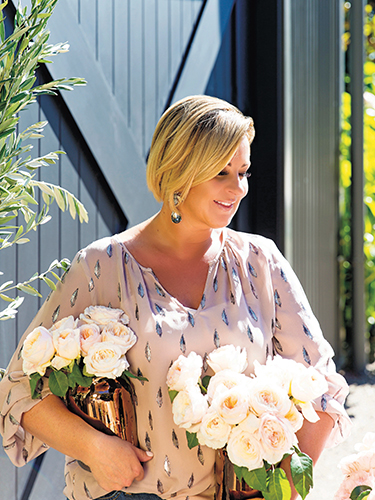27 Jun 2018 |
THE SEMI-NAKED CAKE
The star of my rose-themed afternoon tea is a layered teacake with scrapings of icing, all topped with a handful of fresh rose heads. This style of dessert takes centre stage and is a real
showstopper. The cake is actually three separate cakes layered on top of each other, with two layers of buttercream in between.
5 eggs, at room temperature
450 g (1 lb/2 cups) caster (superfine) sugar
300 ml (10 fl oz) extra-virgin olive oil
300 g (10½ oz/1¼ cups) plain yoghurt
zest of ½ lemon
1½ tablespoons fresh lemon juice
450 g (1 lb/3 cups) self-raising flour
1 teaspoon cinnamon
pinch of salt
roses, to garnish (optional)
Buttercream
500 g (1 lb 2 oz/2 cups) unsalted butter, at room temperature
500 g (1 lb 2 oz/4 cups) icing (confectioners’) sugar
125 ml (4½ fl oz/½ cup) lukewarm full cream (whole) milk
2 tablespoons vanilla extract
MAKES THREE 20 CM (8 IN) ROUND CAKES
Preheat the oven to 180°C (350°F).
Grease the base and sides of three 20 × 5 cm (8 × 2 in) round cake tins. Line each tin with baking paper.
Cream the eggs and sugar in a large bowl using an electric mixer. Gradually add the olive oil until emulsified, then add the yoghurt, lemon zest and juice and beat for 30 seconds until combined. Sift the self-raising flour, cinnamon and salt into the bowl and gently fold in using a metal spoon.
Pour the batter into the prepared cake tins and bake for 45 minutes, or until a skewer inserted in the centre comes out clean. Allow the cakes to cool a little before turning them onto wire racks to cool completely.
To prepare the buttercream, place the butter in a mixing bowl and, using a hand-held electric beater, mix until soft and pale. Gradually add the icing sugar and continue beating well for 5 minutes.
Add the milk (you don’t have to use it all) and the vanilla extract and mix to a smooth consistency.
Place the first cake layer, upside down, on a serving plate. Make sure the bottom is completely flat or you will have a wobbly cake (see the tips on below).
Spread about 1 cup of buttercream on top of the first layer, taking it just past the edges of the first cake. Carefully place the second cake upside down on top of the first cake and repeat the process.
Once you have placed the last cake, spread buttercream on top. Then, using a palette knife or spatula, lightly spread the remaining icing around the outside of the cake, starting from the top and moving down the sides, leaving some of the cake exposed.
Chill the cake in the fridge for 1 hour to set the icing before serving. Garnish with roses, if desired.
Tips for making the perfect semi-naked cake
Grease your pans as well as you can so the cake can be easily removed from the tin and won’t lose its shape. Imperfections can’t be hidden in a cake like this.
Allow time for the cakes to cool before adding icing and stacking them.
If you are worried about your cakes drying out, brush them with a simple sugar syrup, or use rose liqueur for that added hit of flavour.
A strong, thick buttercream filling is a must. You want your layers to sit comfortably on one another without filling oozing out the sides.
For a nice flat finish, trim the top off each cake with a sharp knife to create a stable flat surface, and stack the cakes upside down.
The sides of the cake are the heroes, so go as naked or as dressed as you like. I like an uneven smearing, to make the cake look a little rustic. Make sure you leave a good layer of icing on top for the decorations to sit on.
If you want to create a two-tiered cake, make two-and-a-half batches of the batter and buttercream recipes and use a 24 cm (9½ in) round cake tin for the bottom-tier cakes. Prepare the smaller and larger cakes as described in the recipe, then assemble your tiers once the cakes have chilled to ensure everything is stable.



